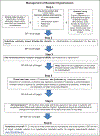Resistant Hypertension: Detection, Evaluation, and Management: A Scientific Statement From the American Heart Association
- PMID: 30354828
- PMCID: PMC6530990
- DOI: 10.1161/HYP.0000000000000084
Resistant Hypertension: Detection, Evaluation, and Management: A Scientific Statement From the American Heart Association
Abstract
Resistant hypertension (RH) is defined as above-goal elevated blood pressure (BP) in a patient despite the concurrent use of 3 antihypertensive drug classes, commonly including a long-acting calcium channel blocker, a blocker of the renin-angiotensin system (angiotensin-converting enzyme inhibitor or angiotensin receptor blocker), and a diuretic. The antihypertensive drugs should be administered at maximum or maximally tolerated daily doses. RH also includes patients whose BP achieves target values on ≥4 antihypertensive medications. The diagnosis of RH requires assurance of antihypertensive medication adherence and exclusion of the "white-coat effect" (office BP above goal but out-of-office BP at or below target). The importance of RH is underscored by the associated risk of adverse outcomes compared with non-RH. This article is an updated American Heart Association scientific statement on the detection, evaluation, and management of RH. Once antihypertensive medication adherence is confirmed and out-of-office BP recordings exclude a white-coat effect, evaluation includes identification of contributing lifestyle issues, detection of drugs interfering with antihypertensive medication effectiveness, screening for secondary hypertension, and assessment of target organ damage. Management of RH includes maximization of lifestyle interventions, use of long-acting thiazide-like diuretics (chlorthalidone or indapamide), addition of a mineralocorticoid receptor antagonist (spironolactone or eplerenone), and, if BP remains elevated, stepwise addition of antihypertensive drugs with complementary mechanisms of action to lower BP. If BP remains uncontrolled, referral to a hypertension specialist is advised.
Keywords: AHA Scientific Statements; antihypertensive agents; hypertension; hypertension resistant to conventional therapy.
Conflict of interest statement
The American Heart Association makes every effort to avoid any actual or potential conflicts of interest that may arise as a result of an outside relationship or a personal, professional, or business interest of a member of the writing panel. Specifically, all members of the writing group are required to complete and submit a Disclosure Questionnaire showing all such relationships that might be perceived as real or potential conflicts of interest.
Figures



References
-
- Whelton PK, Carey RM, Aronow WS, Casey DE Jr, Collins KJ, Dennison Himmelfarb C, DePalma SM, Gidding S, Jamerson KA, Jones DW, MacLaughlin EJ, Muntner P, Ovbiagele B, Smith SC Jr, Spencer CC, Stafford RS, Taler SJ, Thomas RJ, Williams KA Sr, Williamson JD, Wright JT Jr. 2017 ACC/AHA/AAPA/ABC/ACPM/AGS/APhA/ASH/ASPC/NMA/PCNA guideline for the prevention, detection, evaluation, and management of high blood pressure in adults: a report of the American College of Cardiology/American Heart Association Task Force on Clinical Practice Guidelines [published correction appears in Hypertension. 2018;71:e140-e144]. Hypertension. 2018;71:e13–e115. doi: 10.1161/HYP.0000000000000065 - DOI - PubMed
-
- Calhoun DA, Jones D, Textor S, Goff DC, Murphy TP, Toto RD, White A, Cushman WC, White W, Sica D, Ferdinand K, Giles TD, Falkner B, Carey RM. Resistant hypertension: diagnosis, evaluation, and treatment: a scientific statement from the American Heart Association Professional Education Committee of the Council for High Blood Pressure Research. Hypertension. 2008;51:1403–1419. doi: 10.1161/HYPERTENSIONAHA.108.189141 - DOI - PubMed
-
- Pickering TG, Hall JE, Appel LJ, Falkner BE, Graves J, Hill MN, Jones DW, Kurtz T, Sheps SG, Roccella EJ. Recommendations for blood pressure measurement in humans and experimental animals, part 1: blood pressure measurement in humans: a statement for professionals from the Subcommittee of Professional and Public Education of the American Heart Association Council on High Blood Pressure Research. Circulation. 2005;111:697–716. doi: 10.1161/01.CIR.0000154900.76284.F6 - DOI - PubMed
-
- Parati G, Stergiou GS, Asmar R, Bilo G, de Leeuw P, Imai Y, Kario K, Lurbe E, Manolis A, Mengden T, O’Brien E, Ohkubo T, Padfield P, Palatini P, Pickering TG, Redon J, Revera M, Ruilope LM, Shennan A, Staessen JA, Tisler A, Waeber B, Zanchetti A, Mancia G; ESH Working Group on Blood Pressure Monitoring. European Society of Hypertension practice guidelines for home blood pressure monitoring. J Hum Hypertens. 2010;24:779–785. doi: 10.1038/jhh.2010.54 - DOI - PubMed
-
- Mancia G, Bombelli M, Brambilla G, Facchetti R, Sega R, Toso E, Grassi G. Long-term prognostic value of white coat hypertension: an insight from diagnostic use of both ambulatory and home blood pressure measurements. Hypertension. 2013;62:168–174. doi: 10.1161/HYPERTENSIONAHA.111.00690 - DOI - PubMed
Publication types
MeSH terms
Substances
Grants and funding
LinkOut - more resources
Full Text Sources
Other Literature Sources
Medical

